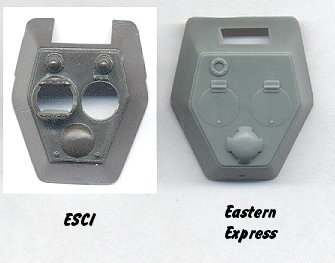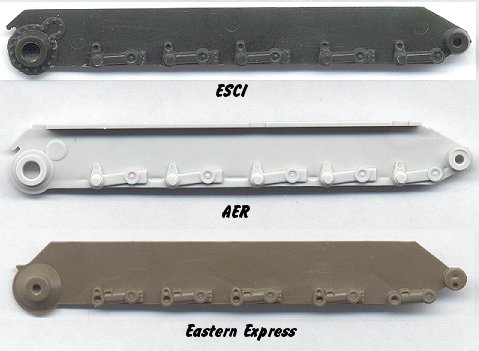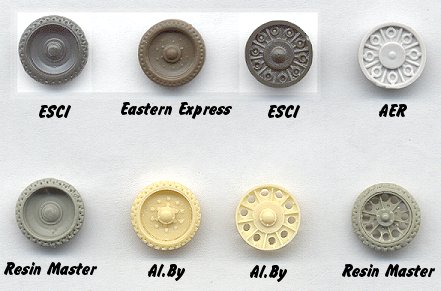
Modeling the T-34 and its Variants
Disclaimer: this article is probably outdated, but might still be useful for owners of the kits mentioned in the article
Introduction
The Soviet T-34 was one of the most important armored fighting vehicles in WW II, and yet its presence in the 1/72nd scale model world was quite lacking until recently. To date, there have been only a handful of injection-molded plastic kits of the T-34 produced. Two of those (the ESCI kits) have been out of production for many years, and one, the AER T-34/85, does not demonstrate the finest model making techniques available today. Luckily, we have recently been provided with another kit from Eastern Express (boxed as several versions), which is a very nice model.
Resin manufacturers have tried to fill the gaps. Over the years, there have been numerous releases of several variants of the T-34 in resin. Some of them are complete kits; most of them are conversion turrets, to be used with existing hulls. Many of the resin conversions are no longer in production, and those that still are being produced, tend to be very rare, and difficult to obtain. So the obvious conclusion is that there is a need for new, injected-plastic T-34 kits in this scale. PST has announced that they will soon also release a line of T-34's, but it is unknown if they will be new-tool, or re-boxes of the Eastern Express kit. Revell AG. has announced a T-34/85 kit for late 2002, which will likely make many of the resin releases superfluous.
Writing a comparative review of all available T-34 kits is not as easy as the other comparative review articles I have written, as there is little overlap between the versions of the T-34 which have been marketed over the years. There were a very large number of T-34 variants produced during World War II, but one common feature they all shared was the main hull of the vehicle, so the majority of this comparison exercise will focus on features of the kit hulls. Many different wheel styles and turrets were introduced throughout the war, several of which are available to model builders in one form or another, so with creative kit-bashing, and access to all of the available model kits, we can build pretty much any of the really common T-34 variants.
There were several self-propelled guns based on the T-34 hull, and three of them have been released in either plastic or resin over the years. The SU-85, SU-122 and SU-100 are all available from a variety of manufacturers. I have only seen the plastic kits of these vehicles, so only they will be reviewed in this article.
I will begin the article with a discussion of the different naming conventions for the T-34. I'll follow that with tables of the many kits and accessories available for the T-34, with hotlinks to various Reviews and Previews. The three manufacturers of plastic T-34 kits, ESCI, AER and Eastern Express, will have extensive in-box previews of their kits. Following those will be a short comparison of the available kits, with comparative parts scans and recommendations. And finally, I will close the article with a bibliography of T-34 reference books in my possession. There are a great many reference books available, and I will continuously update the list as I become aware of new books.
Naming Conventions
There seems to be several different naming conventions used for the T-34. Steven Zaloga, author of many English-language reference books on the T-34, uses a system which differentiates between the oval and hexagonal turrets. However, it seems that most Eastern European authors, including Janusz Ledwoch, author of the Wydawnictwo Militaria T-34/76 book, uses a naming scheme which differentiates between the turrets with and without the commander's cupola. Both of these systems label the tanks with a Year Model after the name, such as "T-34/76 Model 1943". There is also a third naming convention which I have come across in passing, but have not seen a complete listing of, which designates the variants with a letter after the T-34 name, such as "T-34/76c". This naming discrepancy must be kept in mind when reviewing the available kits, because the name "T-34/76 Model 1942" can mean different versions to different manufacturers.
I began this article with the intention of tabulating the many versions of the T-34, showing the differences in the naming conventions for each version. But after about an hour of going through my books, and jotting down notes, I realized that such a task is beyond the scope of this article. There is such a wide variety of variants, and sub-variants, and sub-sub-variants, that in order to make this article manageable (and timely), I will leave that task to the other websites out there devoted to Soviet armor (there are several good ones). Instead, I will simply indicate within the kit reviews, which version is being modeled by that particular kit, based on the following, brief descriptions (from Zaloga):
(Thanks to Doug Clarke for providing the correct letter designations.)
I can't completely follow the scheme which Ledwoch uses (I can't read Polish). He seems to follow the same scheme as Zaloga up to the Model 1942. Here, he continues to call the [Zaloga] Model 1942 a Model 1941. He doesn't switch to the Model 1942 designation until the introduction of the hexagonal turret. He calls the hexagonal turret without a commander's cupola (T-34/76E) the Model 1942, and the hexagonal turret with a commander's cupola (T-34/76F), the Model 1943. But there are also two or three photos of the early, oval turret which he also calls Model 1942, and I don't understand why. If anybody could shed some light on this, I'd appreciate it.
Go To: The Kit Lists
Comparative Review
We now have seven plastic kits of the T-34 from which to choose, although the two ESCI kits are becoming hard to find (the four Eastern Express kits are identical, except for the inclusion of the PT-3 mineroller in one of them). In this section, I'll post some scans of the various kit parts, comparing and contrasting the quality of each kit. I've added an Al.By T-34 kit into the comparisons as well, because it is such a nice kit. If I ever get my hands on any other resin T-34's, I'll add them to the comparison also. The self-propelled gun versions of the T-34 are not included in this comparison, because they are simply modifications to the existing T-34 kits. All of the below comments for the Eastern Express T-34 are applicable to the SU-85 and SU-122. Likewise, the comments for the AER T-34/85 are also appropriate for their SU-100. Complete in-box Previews of all of these kits can be reached through the above link to the Kit Lists.
Hull

As one can see, none of the kit hulls are truly bad. I'd say the roughest one of the bunch is the AER piece, because the engine grates aren't nearly as finely molded as on the other kits, but even so, it's still a fairly decent hull. I like the ESCI and AER hulls for having the option of posing the engine screening hatch open if desired, but the actual hatch on the AER kit (not shown) is not very well done. The Al.By hull was originally based on the ESCI kit, so they are almost identical, but the Al.By has some obvious improvements made to it. I consider this piece to be the best hull of the bunch. My second favorite is the Eastern Express hull. Although the engine screening hatch is molded on, the detail is very fine, and I feel that the shape is more accurate the other hulls. As one can see, the top plate of the hull is shorter than on the other kits, which makes the side walls a hair taller, and the front glacis plate slightly longer. When compared with scale drawings of this tank, I think that this is closer to reality. However, this discrepancy between kits is not really apparent, unless they are sitting next to each other like this.
Dimensions
I scoured several reference books for dimensions of the T-34, and came up with a wide variation between measurements. I've taken the most common ones (which is also close to the average) and included them in the following table:
| Width (mm) | Length (mm) | |
| True T-34 | 3000 | 6100 |
| 1/72nd Scale | 41.7 | 84.7 |
| ESCI | 42.0 | 86.2 |
| AER | 42.4 | 85.0 |
| Eastern Express | 41.9 | 83.0 |
| Al.By | 42.0 | 86.5 |
It's obvious that none of the kits are too far off in any direction. All of the widths are pretty much exact, and the lengths vary from the true 1/72nd measurement by less than 2mm for all kits. Again, I think that you can only see the differences when the kits are placed side by side.
Turret

Since only two of the kits are of the same version (ESCI and Eastern Express Model 1943), the turret comparison is only between those two kits. The other turrets can be viewed on their appropriate Preview pages. Both of the 1943 turrets are very nice, with the ESCI turret just a bit smaller than the Eastern Express example. When comparing these turrets to scale plans, both appear to be a little bit smaller than 1/72nd, but not by much. The ESCI turret looks to be about 1/74th scale, and the EE turret is about 1/73rd.
The ESCI kit has the obvious advantage of open hatches, but other than that, I like the EE turret better. The ventilator cover in particular, is very well done. It also has very fine vision slots on the turret sides, which the ESCI turret lacks, plus nice bolt details around the periscope. The EE commander's cupola is provided as a separate part, and is molded with a closed hatch. The detail on that part is very good. Although not shown, both of the guns and mantlets are very good.
Chassis

There is not a wide range of quality with these parts. Both the ESCI and Eastern Express parts have more, and finer, details than the AER kit, but none of it will be visible on the final model anyway, since the wheels block the view. If somebody wants to make a diorama with a T-34 missing some wheels, then I would steer clear of the AER kit. Notice also the incorrect axle spacing on the AER chassis. There is a semi-circular ring of bolts extending up from rear sprocket mount, best seen on the ESCI part. I don't know what this is, but based on my 1/35th scale T-34 kits, it looks exactly like what is shown on the ESCI kit part. The AER kit part looks wrong, and it is lacking entirely from the EE kit part.
Wheels

The wheels from all the plastic kits are in the top row, and various resin wheels in the bottom row for comparison. Basically, the plastic solid disk wheels are pretty good, while the plastic all-metal wheels are poor. The AER wheel in particular, is very bad (poor depth of detail, and incorrect number of holes). If you want a pierced metal wheel, I'd recommend buying an Al.By kit. As I mention in the Al.By kit review, their wheels are spectacular, and I really wish that Al.By would sell their wheels separately. The Al.By solid disk wheels are likewise incredibly well done. I guess the best plastic wheel is the Eastern Express example, but the hub does not extend out nearly far enough. The Resin Master solid wheel is simply a copy of the ESCI wheel. The Resin Master pierced wheel with rubber tire ("spider" style) is also very good.
Conclusion
My thoughts on these kits is that none of them are truly horrible. The AER T-34/85 is probably the weakest of the lot, but it is the only plastic 85mm version available. If you can get ahold of the a resin replacement turret, I'd recommend using it on either an ESCI or Eastern Express kit hull. Five different resin turrets were made at one time, but now, only the Leva, Al.By and Rhino pieces are still in production. Rhino also makes a complete T-34/85 kit, but I have not seen it to be able to comment on the quality of the hull and wheels.
If a person wishes to build an early T-34/76, the ESCI kit is the only choice, or a Resin Master resin turret on an AER or Eastern Express hull. The 1940 and 1941 Models are only available as turrets from Resin Master. I recommend the Eastern Express Model 1943 over the ESCI kit, but not by much. Numerous resin turrets are available for the various styles of 1943 turret, from Resin Master, Leva and Al.By.
The Al.By T-34 kit I own is far superior to any of the other kits, primarily because of the awesome wheels. These are the only wheels which I consider to be excellent. All of the other plastic wheels range from good to poor. I am tempted to buy as many of the Al.By kits I can find, to use for various conversion projects, and then sell the exta Al.By turrets to help defray the cost.
All in all, I think we small scale modelers are pretty lucky to have enough different kits of the T-34 to be able to make such comparisons. Still needed is a new-tool kit of the early (oval-turret) versions, as well as decent wheels. A new SU-100 would be a good idea also (Hello, Eastern Express?).
Bibliography
Ledwoch, J. 1997. T-34/76. Wydawnictwo Militaria No. 38. Warsaw, Poland. 46pp.
Michulec, R., A. Wrobel and W. Klonski. 1998. Armor Battles on the Eastern Front (1) The German High Tide 1941-1942. Armor At War Series. Concord Publications. Hong Kong. 72pp.
Michulec, R., A. Wrobel and W. Klonski. 1999. Armor Battles on the Eastern Front (2) Downfall of the Reich 1943-1945. Armor At War Series. Concord Publications. Hong Kong. 72pp.
Unknown Japanese Author. 1997. Soviet Military Vehicles of W.W.II. Ground Power No. 1997/9. Delta Publishing, Tokyo, Japan. 144pp.
Zaloga, S., J. Grandsen and D. Greer. 1983. T-34 in Action. Squadron/Signal Publications, Carrollton TX. 50pp.
Zaloga, S., and P. Sarson. 1994. T-34/76 Medium Tank 1941-1945. New Vanguard No. 9. Osprey Publishing, London, England. 48pp.
Zaloga, S., J. Kinnear and P. Sarson. 1996. T-34-85 Medium Tank 1944-1994. New Vanguard No. 20. Osprey Publishing, London, England. 48 pp.
Zaloga, S., J. Kinnear, A. Askenov and A. Koshchavtsev. 1997. Soviet Tanks in Combat 1941-1945 - The T-28, T-34, T-34-85 and T-44 Medium Tanks. Armor At War Series. Concord Publications. Hong Kong. 72pp.
| Back to Articles Page | Back to Home Page |